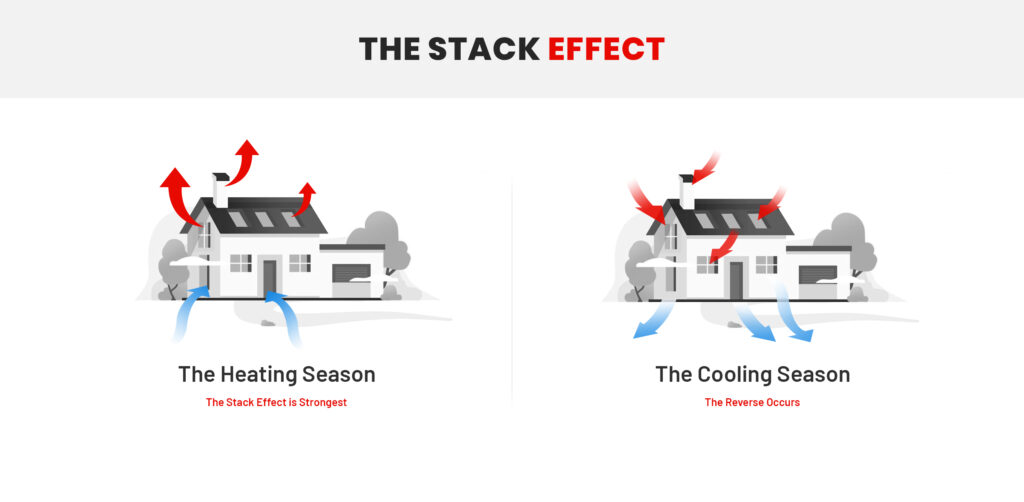Stack Effect

Entry & Exit Points
The entry and exit point can be any gaps or crack in the base of the home that allows air to enter from the outside. Some common areas are often the sill plate and rim joist. Other openings such as plumbing penetrations, electrical penetrations located in the basement or crawlspace ceiling make it easy for air to flow up and into the home.
Health Concerns
Comfortability
Mold & Mildew
High Utility Cost
Stack effect (sometimes called chimney effect) is the movement of air in and out of a building through small or large gaps and openings. Stack effect is caused by the difference in air temperature. The great the temperature difference and the higher the building, the greater the stack effect.
Depending on the temperature inside and outside of a home, stack effect is capable of moving large amounts of air. In the winter time or during the heating season, as you heat your home, the heated air gets lighter and less dense. This causes the heated air to rise and eventually escape to the outside of the home where the air is cooler and more dense. The air is able to move up and out of the home through voids and openings where the drywall meets the framing construction. Large holes and opening are often found where electrical wiring and plumbing pipes are ran throughout the structure of the home. Additionally, cracks and gaps may be found in the ceiling around recessed lighting and recessed exhaust fans.
Consider this, we now understand that stack effect is the phenomenon of warm air rising, creating a positive pressure near the top of the home and escaping to the outside. While that positive pressure is at the top a negative pressure is at the bottom, allowing cold outdoor air to enter. The cold outdoor air entering the base of your home starts to be forced upwards due to stack effect. The lower level of your home starts to feel cold. Naturally, what do we do if an area of our home is cold? We turn up the thermostat, increasing the temperature of the cold air to feel comfortable. The increased temperature creates a larger temperature difference between the inside and outside, increasing the stack effect. The heat is being forced up to the next level of the home where you typically feel warmer or too warm. (Starting to sound familiar?) What happens when that level of the home is too warm? Have you ever just cracked a window to simply cool down for a moment? If the answer is yes, then the stack effect has been increased, causing more cool air to enter through the bottom and rise to the lower level. Occupants on the lower level just can not seem to get warm and they have no other choice but to pull out that electric space heater and plug it in. Once again, increasing the temperature but this time also increasing the utility bill. This stack effect cycle can go on and on causing uneven heating, comfort issues and higher usage.
Just when we think we covered the basics of stack effect. Here comes some more. The fact is stack effect is just not nice to us. We couldn’t leave you without just a bit more understanding of how it works and the importance of correcting or limiting it. Remember, stack effect is allowing cold air to enter the base of the home and forces warm air out. The warm air can contain a lot more water vapor than the cool air entering. As this warm air is driven up and enters spaces such as our attic and comes in contact with cooler surfaces such as the roof or roofing nails, it condenses. This is the same thing that cause morning dew on the front lawn or the windshield of your car. It’s the same as an ice cold glass of water sitting on a table and begins to get wet on the outside of the glass. The real problem is the moisture in an attic could have major concerns. It can reduce the durability out the roof sheeting affecting the roof and shingles. However, most importantly it may cause mildew and mold growth, potentially harming or having concerns to the health and safety of the occupants.

call us to get a free quote
Image by atlascompany on Freepik
